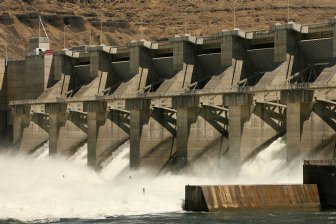forum
library
tutorial
contact

With Higher, Cooler Flows, Biologists Optimistic About
Snake River Sockeye Return To Central Idaho
by Staff
Columbia Basin Bulletin, August 12, 2011
|
the film forum library tutorial contact |

|
With Higher, Cooler Flows, Biologists Optimistic About
by Staff
|
 The numbers of Snake River sockeye making it home to central Idaho has begun to swell with a total of 65 in hand through Thursday.
The numbers of Snake River sockeye making it home to central Idaho has begun to swell with a total of 65 in hand through Thursday.
That already is the fifth highest return in the history of the Snake River Sockeye Salmon Captive Broodstock Program with many more to come.
"It's just getting started," said Dan Baker, manager of the Idaho Department of Fish and Game's Eagle Hatchery. As a part of the program, sockeye spawners returning some 900 miles up the Columbia, Snake and Salmon rivers are trapped at the Stanley Basin's Sawtooth Hatchery or in nearby Redfish Lake Creek. The fish are transferred to Eagle Hatchery and held until the spawning season, which starts next month. Then most of the returned fish will be released into Redfish Lake to spawn and the balance will be used to fuel the captive broodstock program, which began in 1991 after the sockeye population and dropped nearly to extinction.
A relatively big return is expected this year. Through Wednesday a total of 1,480 sockeye had been counted passing the lower Snake River's Lower Granite Dam, which is located in southeast Washington about 400 river miles downstream from Sawtooth Hatchery. That count is second only to last year's tally of 2,201 on a record dating back to 1975.
Baker said with flows that are somewhat higher and cooler than average this year, biologists feel a relatively high number of fish will make that final, 400-mile leg of the journey. The peak passage at the dam was 110 on July 14 and 97 the following day. It takes about four weeks for the sockeye to swim from Lower Granite to the Idaho high country.
Sockeye began arriving this year on Aug. 1 when a single fish was trapped at Sawtooth. The daily trapping totals have slowly risen, with 17 registered Thursday.
The total so far includes 23 "natural" returns that are either the product of Redfish Lake anadromous spawners, the outplant of fertilized eggs in Pettit and Alturas lakes or from "residual" sockeye that spent their entire life cycle in the lakes.
Since 1999, when the first products of the captive brood program made it back to the Sawtooth Valley from the Pacific Ocean, the highest return was 1,355 last year.
learn more on topics covered in the film
see the video
read the script
learn the songs
discussion forum
